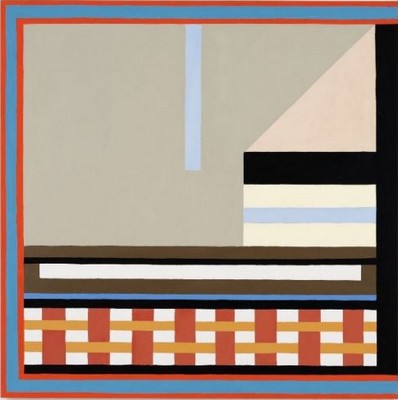Nathalie Du Pasquier
LE CORBEAU ET LE RENARD
Pace Gallery, London
April 28 – May 25, 2023
Untitled, 2022
Oil on Canvas, 100 x 100 cm
© Nathalie Du Pasquier
Pace Gallery presents LE CORBEAU ET LE RENARD, a solo exhibition of Milan-based artist, NATHALIE DU PASQUIER. Taking over one of the Hanover Square gallery spaces in her idiosyncratic style, this exhibition marks the artist’s first show in the UK for more than five years. Nathalie Du Pasquier presents a suite of new paintings and constructions in her signature visual lexicon of vivid colours and modular forms.
Expanding the language of her paintings onto the walls and into the centre of the gallery space, Nathalie Du Pasquier’s distinctive approach to art making is immersive and deeply stimulating. At the core of the artist’s practice is an exploration of form, colour, and space through subversive and unexpected means. Firmly centred in the practice of painting, her work draws inspiration from a myriad of visual sources that range from the Italian Metaphysical painters, to modernist architecture, furniture, and functional objects. Nathalie Du Pasquier conceives her exhibitions as a total work of art, painting the walls with a bespoke design that activates the gallery space and constructs a visual rhythm through which dynamic dialogues between painting and object are formed. This all-encompassing conception of an exhibition speaks not only to the relationships between objects, but also the viewer’s place within the space.
Displayed in the centre of the gallery, Nathalie Du Pasquier’s wooden constructions represent a very recent development in her practice, bringing her paintings into three-dimensions to be seen from multiple vantage points. Akin to the renowned architectural installations displayed in recent major exhibitions at the Le Corbusier designed Villa Savoye in Poissy, France, the Palais de Tokyo in Paris, France, and the MACRO in Rome, Italy, these painted wooden works appear to leap from the gallery wall and enter the viewer’s physical space.
Replete with spatial tension, Nathalie Du Pasquier’s visual lexicon is rooted in juxtaposition. Newly conceived, her constructions contain soft curves of painted wooden forms set against incisive, rectangular edges. Likewise, earth-toned hues of blue, green, beige, and brown contrast brilliant reds and yellows. The result is a vibrant and expressive energy that draws viewers into Nathalie Du Pasquier’s unique vision. Her use of unmodulated colour obfuscates traditional perceptions of depth, confounding expectations to provoke engagement with the forms themselves, as well as the qualities inherent to canvas or wood. Instead, some works use colour to suggest a sense of perspective; grey or black forms may recall a sharp shadow in the vein of artists such as Giorgio Morandi and Giorgio de Chirico, whose mysterious, unsettling compositions hold significant inspiration for Du Pasquier.
Borrowing its title from a well-known French moral fable by Jean de La Fontaine, LE CORBEAU ET LE RENARD is a lesson in complacency, warning against egos inflated by flattery. While the works in this playful exhibition do not make direct reference to the poem, in titling the exhibition after this children’s tale, Nathalie Du Pasquier is inviting viewers to engage with artworks and gallery spaces with fresh eyes.
NATHALIE DU PASQUIER (b. 1957, Bordeaux, France) is recognized for her painting practice and her design work, which she developed as a member of Memphis, the Milan-based group founded in 1981 by Ettore Sottsass. Before moving to Milan in 1979, Du Pasquier spent a year in Africa, living and traveling in Gabon, Mali, and Niger, where she was exposed to textiles and graphics. Self-taught, she used drawing as a starting point for her own designs, which were applied to textiles and used as the surface patterns for furniture. In 1987, Du Pasquier shifted away from the design of graphic elements and dedicated herself principally to painting. Through her work, she explores various modes of representation, driven by her observation of the world and her interest in perception. She often works from models, painting still lifes that are not depictions of reality but increasingly abstract transformations of shapes and the relationships between various elements. Her models are constructions that she builds with painted geometric forms; since 2001, these have come to constitute a three-dimensional element of her practice that exist as autonomous artworks.
PACE GALLERY
5 Hanover Square, London

